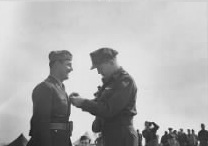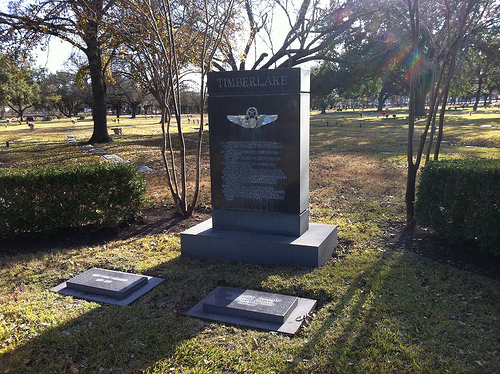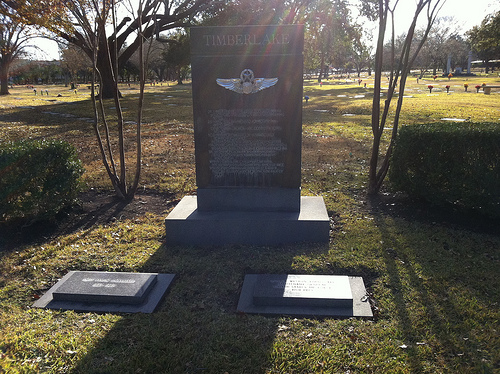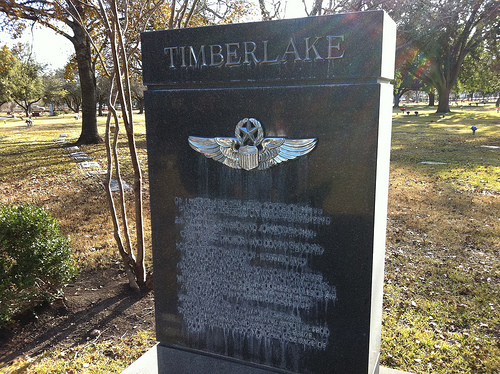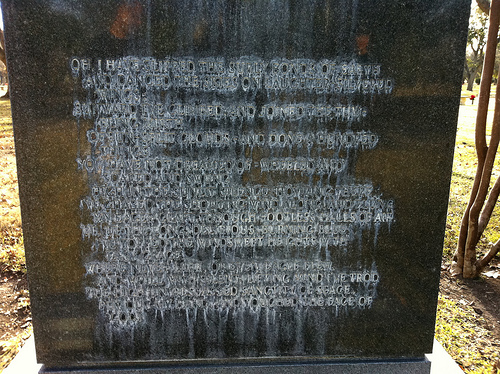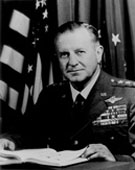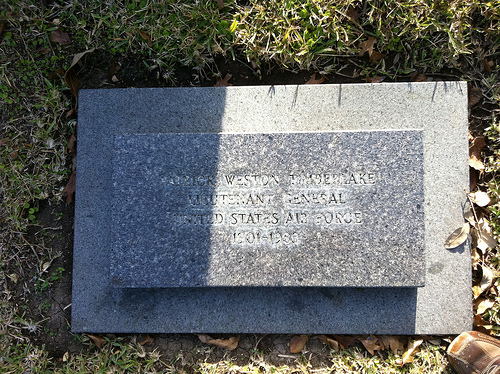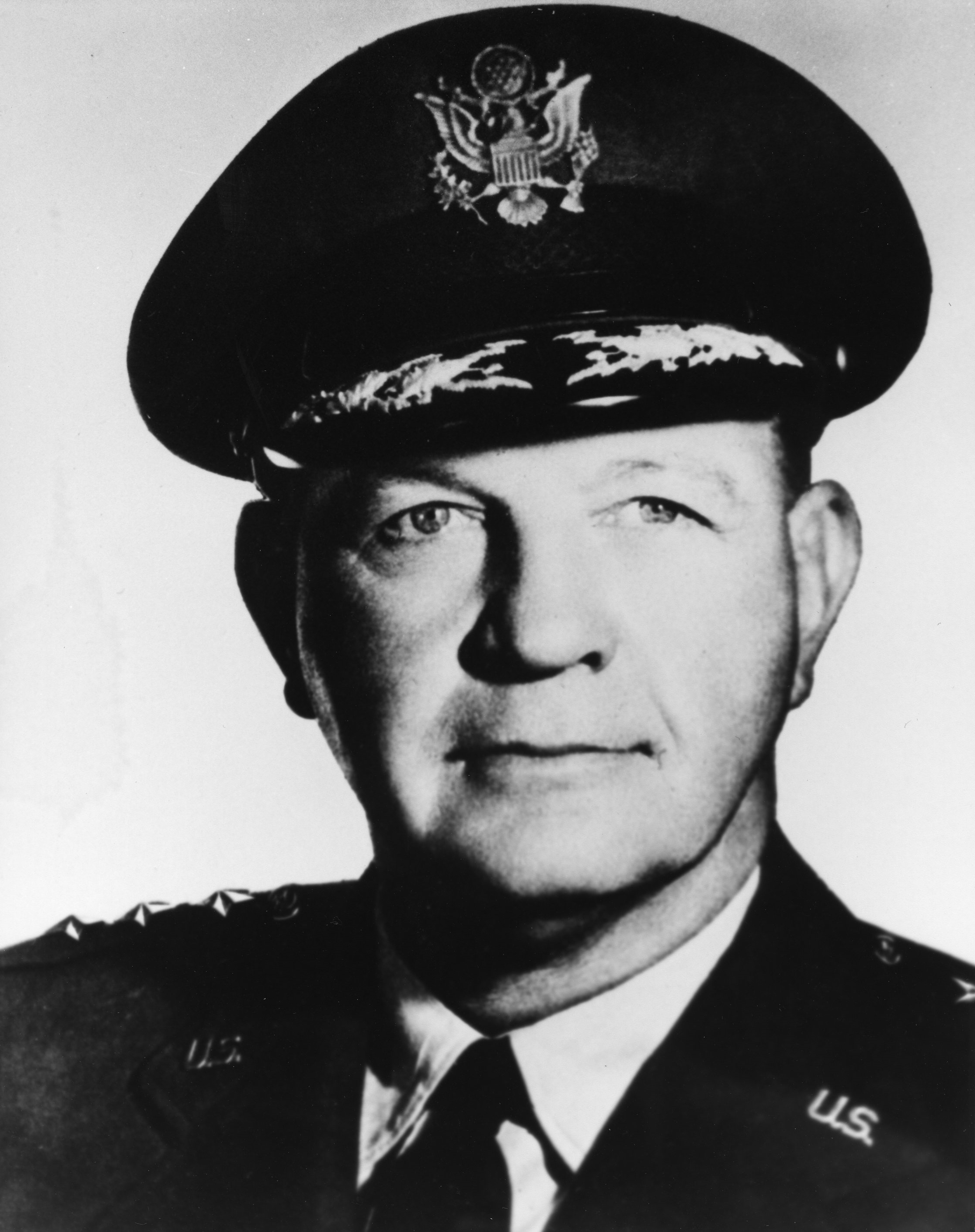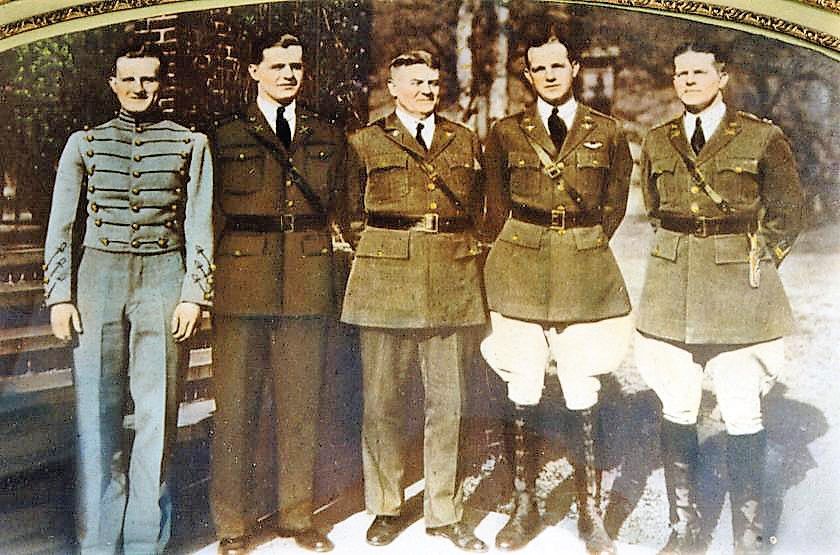Patrick Weston Timberlake was the second of four sons born to Edward Julius and Augusta "Wrenne" Timberlake. Patrick's father, Colonel Edward J. Timberlake, U.S. Army, was a ramrod-straight soldier, USMA Class of 1893, who played for West Point in the first Army-Navy football game in 1890. On duty at West Point from 1919-29, Colonel Timberlake proudly watched an unbroken succession of his sons passing through. In fact, from 1914 when the oldest son entered the U.S. Military Academy, until 1931 when the youngest son was graduated, West Point was never without a Timberlake cadet!
Patrick enrolled in the U.S. Military Academy where he played football as a tight end. He had a critical role in the Army–Navy Game in 1922, catching the go-ahead touchdown in the 4th quarter to beat the Midshipmen 17-14. He graduated from West Point on 12 June 1923, and was commissioned as a Second Lieutenant of Field Artillery and assigned to the Sixth Field Artillery at Fort Holye, MD. In July 1925, Timberlake transferred to the 17th Field Artillery at Fort Bragg, NC.
In September 1925, Patrick made a move that completely altered the course of his military career; he entered Primary Flying School at Brooks Field, TX, followed by the Advanced Flying School at Kelly Field, TX. Upon graduation in March 1926, Patrick was assigned to bombers in the Second Bomb Group at Langley Field, VA, shortly before the formation of the US Army Air Corps on 2 July 1926. He returned to Brooks Field in June 1927 for temporary duty and in October he was sent to March Field, CA, as a flying instructor. He was transferred to the Army Air Force in February 1928.
Timberlake was transferred to the Panama Canal Zone with the 24th Pursuit Squadron in 1929. In 1931, he got a command with the 78th Pursuit Squadron. He enrolled in the Air Corps Engineering School in 1933. He was then assigned to the Aircraft Branch of the Air Corps Materiel Division and, in October 1935, was appointed Chief of the Attack and Observation Engineering Unit there. In the years that followed, he attended the Air Corps Tactical School and the Command and General Staff School.
In July 1942, he entered combat operations in World War II as a Colonel in North Africa in charge of Ninth Bomber Command. He was appointed Director of Operations and Plans for British Air Chief Marshal Tedder in 1943 and, after the formation of the Mediterranean Air Command, took over as Tedder's Chief of Staff. During this time he helped in the planning and execution of the campaigns in North Africa, Pantelleria, Sicily and mainland Italy.
Returning to Air Force Headquarters in April 1944, General Timberlake was named Deputy Chief of Air Staff and, that November, assumed additional duty as a member of the Air Force Board on Transfer of Radar and Communications Responsibilities. He joined the Eighth Air Force at Peterson Field, CO, in July 1945, and went with it to Okinawa, becoming its Chief of Staff under General Jimmy Doolittle. In December, he assumed command of the Eighth Air Force. In July 1946 he took command of the First Air Division in the South Pacific.
Timberlake joined the Army-Navy Munitions Board (re-designated the Department of Defense Munitions Board the following month) in December 1946; in October 1947 he was appointed Air Force Member of the Executive Committee. The following August he was named Director for Military Programs, with additional duty as Deputy Director of the Staff and, in October 1949, was designated Director of the Staff of the Munitions Board. Reassigned to Air Force headquarters in December l950, Timberlake was named Director of Installations in the Office of the Deputy Chief of Staff for Materiel and, in January 1952, became Assistant Deputy Chief of Staff for Operations there.
He assumed command of the Air Proving Ground Command at Eglin AFB from 1952-55. In April 1955, he was transferred to Supreme Headquarters, Allied Powers in Europe (SHAPE) where he was appointed as Commander, Allied Air Forces in Southern Europe, with headquarters in Naples, Italy. Timberlake retired as a Lieutenant General in 1957.
He was rated a Command Pilot, Combat Observer and Aircraft Observer.
Medals and Awards
Distinguished Service Medal
Legion of Merit (2 Awards)
Bronze Star Medal
In Retirement
In his post-military career, Timberlake worked with Northrop Corporation.
Personal
On 5 April 1927, Patrick married Emily Bynum and no children were born of their marriage. Patrick passed away in San Antonio, TX in 1983; Emily died in 1990.
About the Four Timberlake Brothers
After their graduation from West Point, two brothers chose to serve in the Coast Artillery; the other two chose the Air Corps. The second youngest, J. Coleman Timberlake, died in 1938, at age 32, but his three brothers carried on the family's military tradition in notable style. The youngest, Edward J. "Ted" Timberlake Jr., like Patrick, was a highly decorated bomber pilot. He was promoted to Brigadier General at age 33, thus becoming the youngest general officer since the Civil War. And, again like Patrick, Ted retired as an Air Force Lieutenant General. The oldest brother, Edward Wrenne "Ed" Timberlake, perversely (according to his brothers) became an expert in shooting planes down, and once commanded the anti-aircraft defenses of Washington, DC. He earned the star of a Brigadier General in the Army.
Gen Edward Wrenne Timberlake
Gen Edward Julius "Ted" Timberlake, Jr
Three sons who survived to live long lives and all became general officers – quite a family.
Honors
Lt Gen Patrick W. Timberlake has Honoree Record 3306 at MilitaryHallofHonor.com.
Bio compiled by Charles A. Lewis
Patrick Weston Timberlake was the second of four sons born to Edward Julius and Augusta "Wrenne" Timberlake. Patrick's father, Colonel Edward J. Timberlake, U.S. Army, was a ramrod-straight soldier, USMA Class of 1893, who played for West Point in the first Army-Navy football game in 1890. On duty at West Point from 1919-29, Colonel Timberlake proudly watched an unbroken succession of his sons passing through. In fact, from 1914 when the oldest son entered the U.S. Military Academy, until 1931 when the youngest son was graduated, West Point was never without a Timberlake cadet!
Patrick enrolled in the U.S. Military Academy where he played football as a tight end. He had a critical role in the Army–Navy Game in 1922, catching the go-ahead touchdown in the 4th quarter to beat the Midshipmen 17-14. He graduated from West Point on 12 June 1923, and was commissioned as a Second Lieutenant of Field Artillery and assigned to the Sixth Field Artillery at Fort Holye, MD. In July 1925, Timberlake transferred to the 17th Field Artillery at Fort Bragg, NC.
In September 1925, Patrick made a move that completely altered the course of his military career; he entered Primary Flying School at Brooks Field, TX, followed by the Advanced Flying School at Kelly Field, TX. Upon graduation in March 1926, Patrick was assigned to bombers in the Second Bomb Group at Langley Field, VA, shortly before the formation of the US Army Air Corps on 2 July 1926. He returned to Brooks Field in June 1927 for temporary duty and in October he was sent to March Field, CA, as a flying instructor. He was transferred to the Army Air Force in February 1928.
Timberlake was transferred to the Panama Canal Zone with the 24th Pursuit Squadron in 1929. In 1931, he got a command with the 78th Pursuit Squadron. He enrolled in the Air Corps Engineering School in 1933. He was then assigned to the Aircraft Branch of the Air Corps Materiel Division and, in October 1935, was appointed Chief of the Attack and Observation Engineering Unit there. In the years that followed, he attended the Air Corps Tactical School and the Command and General Staff School.
In July 1942, he entered combat operations in World War II as a Colonel in North Africa in charge of Ninth Bomber Command. He was appointed Director of Operations and Plans for British Air Chief Marshal Tedder in 1943 and, after the formation of the Mediterranean Air Command, took over as Tedder's Chief of Staff. During this time he helped in the planning and execution of the campaigns in North Africa, Pantelleria, Sicily and mainland Italy.
Returning to Air Force Headquarters in April 1944, General Timberlake was named Deputy Chief of Air Staff and, that November, assumed additional duty as a member of the Air Force Board on Transfer of Radar and Communications Responsibilities. He joined the Eighth Air Force at Peterson Field, CO, in July 1945, and went with it to Okinawa, becoming its Chief of Staff under General Jimmy Doolittle. In December, he assumed command of the Eighth Air Force. In July 1946 he took command of the First Air Division in the South Pacific.
Timberlake joined the Army-Navy Munitions Board (re-designated the Department of Defense Munitions Board the following month) in December 1946; in October 1947 he was appointed Air Force Member of the Executive Committee. The following August he was named Director for Military Programs, with additional duty as Deputy Director of the Staff and, in October 1949, was designated Director of the Staff of the Munitions Board. Reassigned to Air Force headquarters in December l950, Timberlake was named Director of Installations in the Office of the Deputy Chief of Staff for Materiel and, in January 1952, became Assistant Deputy Chief of Staff for Operations there.
He assumed command of the Air Proving Ground Command at Eglin AFB from 1952-55. In April 1955, he was transferred to Supreme Headquarters, Allied Powers in Europe (SHAPE) where he was appointed as Commander, Allied Air Forces in Southern Europe, with headquarters in Naples, Italy. Timberlake retired as a Lieutenant General in 1957.
He was rated a Command Pilot, Combat Observer and Aircraft Observer.
Medals and Awards
Distinguished Service Medal
Legion of Merit (2 Awards)
Bronze Star Medal
In Retirement
In his post-military career, Timberlake worked with Northrop Corporation.
Personal
On 5 April 1927, Patrick married Emily Bynum and no children were born of their marriage. Patrick passed away in San Antonio, TX in 1983; Emily died in 1990.
About the Four Timberlake Brothers
After their graduation from West Point, two brothers chose to serve in the Coast Artillery; the other two chose the Air Corps. The second youngest, J. Coleman Timberlake, died in 1938, at age 32, but his three brothers carried on the family's military tradition in notable style. The youngest, Edward J. "Ted" Timberlake Jr., like Patrick, was a highly decorated bomber pilot. He was promoted to Brigadier General at age 33, thus becoming the youngest general officer since the Civil War. And, again like Patrick, Ted retired as an Air Force Lieutenant General. The oldest brother, Edward Wrenne "Ed" Timberlake, perversely (according to his brothers) became an expert in shooting planes down, and once commanded the anti-aircraft defenses of Washington, DC. He earned the star of a Brigadier General in the Army.
Gen Edward Wrenne Timberlake
Gen Edward Julius "Ted" Timberlake, Jr
Three sons who survived to live long lives and all became general officers – quite a family.
Honors
Lt Gen Patrick W. Timberlake has Honoree Record 3306 at MilitaryHallofHonor.com.
Bio compiled by Charles A. Lewis
